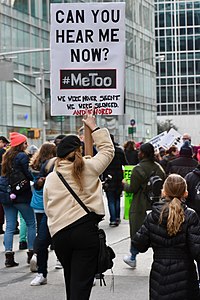
Photo from wikipedia
OBJECTIVES Determine the influence of movement profile on systemic stress and mechanical loading before and after high training load exposure. DESIGN Cross-sectional cohort study. METHODS 43 physically active, college-aged field… Click to show full abstract
OBJECTIVES Determine the influence of movement profile on systemic stress and mechanical loading before and after high training load exposure. DESIGN Cross-sectional cohort study. METHODS 43 physically active, college-aged field or court sport female athletes participated in this study. Participants were assigned to a "excellent" (n=22; age=20.5±1.9yrs, height=1.67±0.67m, mass=64.5±7.8kg) or "poor" (n=21; age=20.4±1.3yrs, height=1.69±0.67m, mass=60.9±6.1kg) movement group defined by The Landing Error Scoring System. Participants completed five cycles of high training load exercise of 5-min treadmill-running at a speed coincident with 100-120% ventilatory threshold and 10 jump-landings from a 30-cm box. Jump-landing vertical ground reaction force and serum cortisol were evaluated prior to and following exercise. Vertical ground reaction force ensemble averages and 95% confidence interval waveforms were generated for pre-exercise, post-exercise, and pre-post exercise changes. A two-way mixed model ANOVA was used to evaluate the effect of movement profile on systemic stress before and after exercise. RESULTS There was no significant difference in changes in serum cortisol between the poor and excellent groups (p=0.69) in response to exercise. Overall, individuals in the poor group exhibited a higher serum cortisol level (p<0.05, d=0.85 [0.19,1.48]). The poor group exhibited higher magnitude vertical ground reaction force prior to (d=1.02-1.26) and after exercise (d=1.15) during a majority of the stance phase. CONCLUSIONS Individuals with poor movement profiles experience greater mechanical loads compared to individuals with excellent movement profiles. A poor movement profile is associated with greater overall concentrations of circulating cortisol, representative of greater systemic stress.
Journal Title: Journal of science and medicine in sport
Year Published: 2019
Link to full text (if available)
Share on Social Media: Sign Up to like & get
recommendations!